To say that 2025 is proving a tumultuous time for B2B marketing (or anything else) feels like a gross understatement.
Between inflation, continued supply chain disruptions, interest rate hikes, and the unfolding consequences of tariffs, it’s little wonder that B2B organizations everywhere are feeling more than a little uncertain about the future. And as B2B marketers unfortunately know, when organizations are faced with uncertainty about their health, they look at adjusting their marketing budgets for relief all too frequently.
According to Forrester’s Budget Planning Guide 2025: B2B Marketing Executives, nearly half (47%) of global B2B marketing decision-makers said they were expecting only between a 1% and 4% growth in their marketing investment, which, accounting for inflation, equates to essentially no gain at all. Meanwhile, the pressure to prove the ROI for these budgets to hold onto them is reaching a fever pitch as the C-suite adjusts to rapidly shifting market realities.
Clearly, B2B marketers have their work cut out for them this year by making more out of less. It’s not all bad news, however. As B2B marketers look for ways to innovate without increasing spending and prove their budgets to the C-suite, emerging technologies and trends may hold exciting new solutions. And based on what we’ve seen so far this year, B2B marketers are taking advantage.
These are a few of the most prominent trends in B2B budgeting in 2025 so far, and what we can learn about the state of the industry by analyzing them.
Concerns guide but do not slow tremendous AI investment
Salesforce recently published its ninth edition of the State of Marketing report, for which it surveyed nearly 5,000 B2B and B2C marketer leaders worldwide to understand how the marketing world is changing in 2025. The top section of their report summarizes arguably this year’s most pivotal budget trend: “AI tops marketing’s agenda.”
Three out of four (75%) marketers are either experimenting with or have already fully implemented AI into their operations — up from 68% in 2022. These adoptees are clearly reaping huge benefits, as high-performing marketers are 2.5x more likely to have fully implemented AI within their operations than underperformers.

Source: Salesforce
This massive adoption of AI coincides with a shift in how marketers are thinking about ways in which the technology can help them. In the State of AI in B2B Marketing in 2024, ON24 asked 500 B2B marketers what they considered the biggest reasons to invest in AI now, rather than waiting for the technology to develop further. Their responses are eye-opening:
Four out of the five top reasons marketers cited for investing in AI now are explicitly financially motivated: marketers believe AI will help them become more efficient (52%), save time (50%), improve their ROI (48%), and drive better business results (44%).
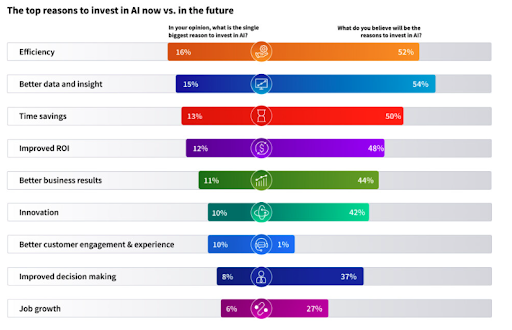
Source: ON24
B2B marketers are thinking of AI as a powerful tool for helping them make and prove their impact on ROI — and therefore help them preserve their budgets in a time when they’re under considerable pressure to do so. ON24’s report also found that 85% of organizations said businesses using AI will see stronger revenue performance than those that don’t.
This perception is also affecting how B2B marketers are using AI. This year, more B2B marketers (63%) use AI for creating promotional content more than anything else. But many of these marketers say they will be prioritizing using it for longer-form content development, analytics and measurement, and webinars and virtual events this year or next year. As B2B marketers become more aware of the impact AI can have on their revenue generation, they’re willing to utilize it for more significant aspects of their processes.
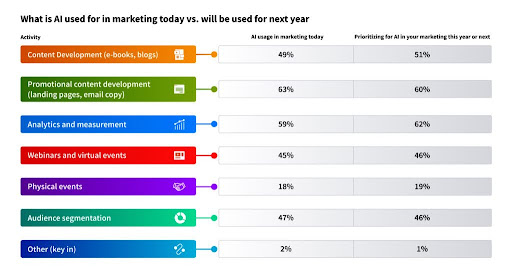
Source: ON24
Despite how enthusiastic B2B marketers’ adoption of AI has become, however, it’s still in its relatively early stages. According to Salesforce, only 34% of all marketers (and only 41% of high-performers) feel they’ve unlocked the full value of AI.
In addition to frustrations with how effectively they can adopt the technology, substantial concerns about AI itself remain for many marketers. Salesforce found that 41% of CMOs are concerned about the data exposure use of AI opens them up to, while a Forbes interview of prominent marketers found many concerned about the homogenization of AI content leading to a dilution of their brand voice.
Of course, these concerns aren’t slowing down B2B marketers’ adoption of GAI — in fact, they may be indirectly accelerating it. One example is TopRank Marketing’s own policy on GAI adoption, which we’re calling “The New AI.”
From our perspective, the shortcomings of GAI are no reason to avoid using it. Instead, we view them as a call to action to get better at using it. TopRank plans to increase our investment in GAI and, just as crucially, GAI training and knowledge-building for our team. This will help us humanize AI and mitigate its flaws while embracing its potential. Expect B2B marketers everywhere to adopt a similar approach, especially as AI technology continues to evolve.
Striking a balance between brand and demand
“Brand building is essential to corporate strategy — and sales will typically say that it’s needed to drive growth — yet when budgets are squeezed, brand is often one of the first casualties … Changing perceptions on the value of brand investments requires an intentional approach and alignment with the executive team.” – Karen Tran, Forrester
Whenever B2B marketers feel pressure to demonstrate pipeline impact, they tend to turn to demand generation, which is easier to measure and prove. Given how uncertain most B2B organizations feel in 2025, it’s not surprising that most B2B marketers are citing demand generation marketing as their current No. 1 priority.
Three in five of the B2B marketers surveyed for LinkedIn’s 2024 B2B Marketing Benchmark report said they had increased their budget allocation for lead generation. They also indicated that 60% of their 2024 marketing budgets was allocated toward generating new business, while 40% was devoted to retaining existing business.
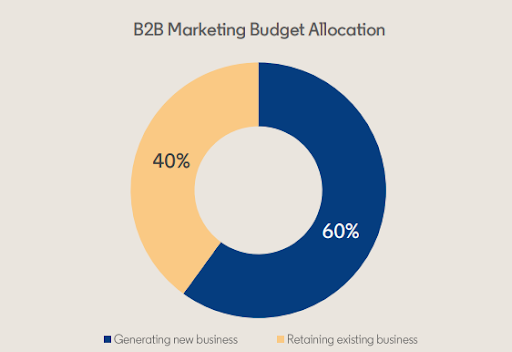
Source: LinkedIn
The gravitation toward investing in demand generation reflects B2B marketers’ long-term struggle with proving ROI, especially to the C-suite. Theoretically, demand generation offers a way to make the most direct possible case for marketing budget ROI, but it carries an inherent risk of locking marketing teams into vicious cycles of “short-termism.”
Fortunately, while B2B marketers are prioritizing demand generation in 2025, they are also carefully leaving room in their budgets to balance these initiatives with brand building.
Ample research demonstrates that B2B marketers are not letting brand building take a backseat in 2025. For example, HubSpot’s 2025 State of Marketing Report found that 92% of all marketers (B2B and B2C included) plan to maintain or increase their investments in brand awareness in 2025.
This report also found that the top two marketing roles CMOs expected to hire in 2025 included Social Media Coordinator (16%) and Content Creator (16%). These were followed by Social Media Strategist (15%) and Creative Director (14%).

Source: HubSpot
These results are corroborated in LinkedIn’s B2B Marketing Benchmark. That survey showed more than two in three (67%) respondents had increased investment in brand building in 2024. Again, this seems to be a trend that has high-level support, as LinkedIn’s report also found that 88% of CMOs are advocating for bolder creative campaigns.
As these trends indicate, B2B marketers are not neglecting brand awareness as an essential aspect of demand generation and ultimately revenue impact. Even while faced with ROI pressure and financial hurdles, the most strategic marketers will continue to emphasize brand as a critical investment priority.
“The past few years of expensive capital and tight budgets pushed many companies to cut back even more on harder-to-measure brand investments. Now the pendulum must swing back. The modern B2B buying journey demands it. We’ve come to accept that only ~5% of buyers are actively in-market. The other 95% aren’t looking to buy—yet. But they will. And when they do, their awareness and perception of your company’s brand determines whether you make the shortlist and win.” – Jon Miller (via MarketingProfs)
Invest in influence continues to grow
As AI continues to proliferate, and concerns about the authenticity and quality of content rise along with it, B2B marketers are increasingly turning to influencer marketing as a solution.
Almost all of the B2B marketers surveyed for TopRank’s 2025 B2B Influencer Marketing Report either already have a dedicated budget for influencer marketing or were planning to establish one this year. Over half (53%) of B2B marketing teams with an existing budget for influencer marketing also said that the budget would increase in 2025.
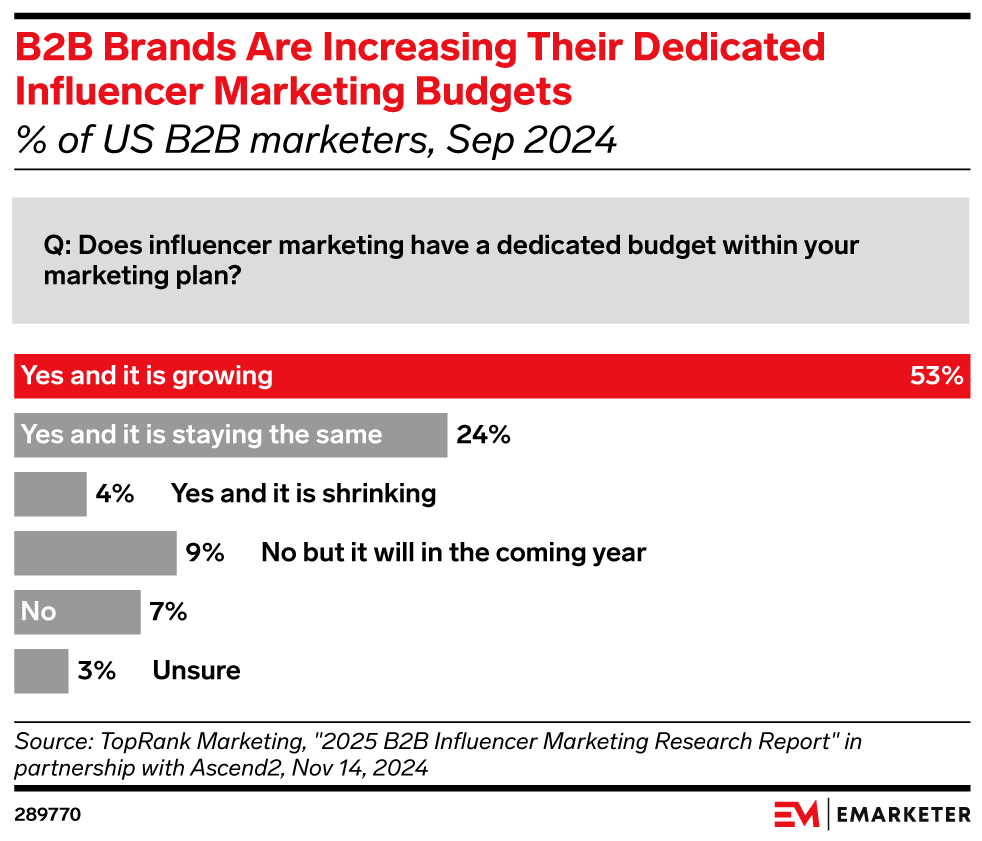
Source: EMARKETER
The Influencer Marketing Report also found that the C-suite was more likely to report that their influencer marketing budget was growing than any other role (76%), indicating considerable enthusiasm for the strategy at the upper levels of B2B organizations.
Nearly half (49%) of practitioners say the most important emerging trend in B2B influencer marketing this year will be “integrating their programs with a greater mix of marketing tactics.” As their budgets expand and programs mature, expect to see B2B influencer marketers thinking outside the box and collaborating with influencers on diverse content and approaches to driving results.

Source: TopRank Marketing
As for why this mix has become so important, practitioners cite how authentic and human-centric influencer marketing feels to B2B customers. Sydney Dusselier at Tiree told us she believes B2B companies will continue to invest more in co-created content with influencers because this content helps build more genuine, memorable connections between B2B brands and their audiences:
“I believe the future of B2B influencer marketing will have companies investing more of their marketing budgets in co-created content with influencers on emerging platforms like TikTok and Instagram … Growth-focused companies who prioritize building a genuine connection with popular and up-and-coming influencers will have the competitive advantage over businesses that focus only on in-house created content.” Sydney Dusselier, Senior Writer, Tiree (From our blog: The Future of B2B Influencer Marketing)
With B2B marketers increasingly relying on influencer marketing as a differentiating tactic, many are reaping the rewards of working with agencies that specialize in the practice.
Influencer marketing can be very challenging and time-consuming because every influencer search is unique to the individual program. Working with experts can help circumvent time and resource barriers to influencer marketing and help B2B teams capitalize on the opportunities to the fullest. Marketers surveyed for TopRank’s B2B Influencer Marketing Report cited time savings (37%), expertise and experience (37%), and finding the right influencers (35%), as the top three benefits from working with influencer marketing agencies, among many others.
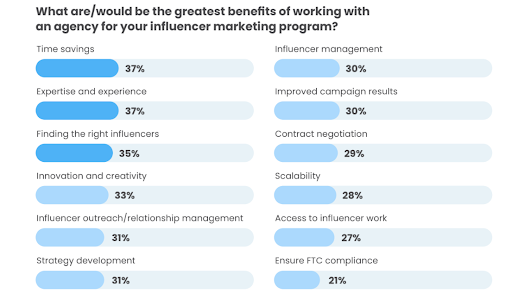
Source: TopRank Marketing
Standing out and proving impact with authenticity
2025 is proving to be an unsettling and somewhat anxiety-inducing year for everyone, not just B2B marketers. To their credit, it seems like marketers are planning their strategies accordingly.
In a time when everyone’s under a lot of pressure to prove their worth, B2B marketers are investing in building authentic, personalized connections with their target audiences. The more B2B marketers can demonstrate that they understand their customers’ uncertainty and are ready to help address them, the stronger these connections will become — and the more budgets will grow in the future. To get a more complete picture of how B2B marketers are investing in influencer marketing in 2025, check out our report on the latest budget trends. And if you’re inspired to try influencer marketing yourself, get in touch with our experts for help today.



